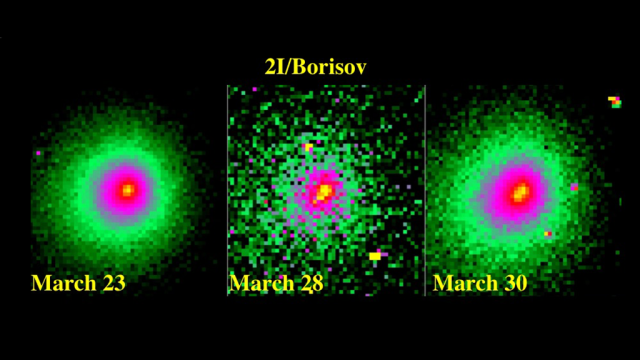Recent images of the second interstellar comet known to have visited the solar system appear to reveal a fragment or fragments falling off of its core.
Comet 2I/Borisov arrived with much fanfare late last summer when scientists realised that had a hyperbolic orbit—implying that it was a visitor from outside the solar system. But unlike the first known visitor, Borsiov has allowed for closer inspection as it orbits the Sun. Recent observations have revealed that it’s losing matter.
“We’ve been looking at this thing with space telescopes for months since it was discovered,” UCLA astronomer David Jewitt told Gizmodo. “We just noticed this change in appearance—that it split into two parts—this week.”
An image that Jewitt posted on the Astronomer’s Telegram yesterday taken with the Hubble Space Telescope shows the comet as one piece as early as March 23 but appearing to split into two pieces by March 28.
But the comet probably hasn’t fractured in half, Jewitt said. Other comets have changed appearance like this before; Borisov has likely just lost a fragment equaling less than 1 per cent of its mass. However, that small fragment is extremely bright, which astronomers believe is due to the fact that it was a previously unexposed icy bit that has now become extremely active as a result of energy from the Sun.
Jewitt isn’t the only team to observe fragmenting of the comet. Another Astronomer’s Telegram post yesterday also reported evidence a small fragment separating from the rock. All of this follows a pair of outbursts from the comet reported on March 12 by a team of astronomers in Poland.
Amateur astronomer Gennady Borisov first spotted this interstellar visitor on August 30 last year, and scientists soon confirmed it as the second interstellar object (the first being 2017’s ‘Oumuamua). But unlike the rocky ‘Oumuamua, comet Borisov looked surprisingly familiar—that is, like an icy solar system comet with a cloud called a coma and a tail that just so happened to have arrived from outside the solar system.
Scientists have tracked the object with space-based telescopes since it passed closest to the Sun back in December. They’ve already learned more about it, said Jewitt. Initial estimates suggested that Borisov was large (perhaps 8 kilometers across), but later observations have instead pegged its radius at a few hundred meters. It has a composition similar to solar system comets, with water ice quickly turning into gas. But, said Jewitt, it appears to have larger dust grains and more carbon monoxide than solar system comets do. Carbon monoxide is a volatile element that would otherwise sublimate off of the comet’s surface from solar energy but hadn’t in the case of Borisov. “This thing has been in a cold place for a long period of time,” Jewitt said.
Does this mean that Borisov is breaking up? It’s not clear yet. Jewitt hopes that it does—for one thing, it would be a cool show, but it would also provide knowledge as to the composition of its core and other physical properties.
Scientists are continuing to monitor the comet Borisov. We hope it breaks up into pieces, too.
